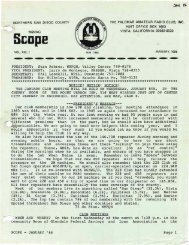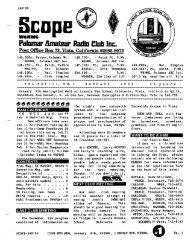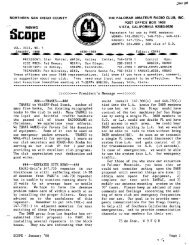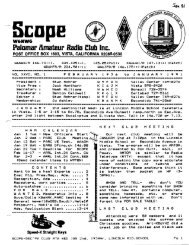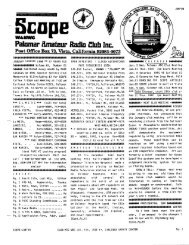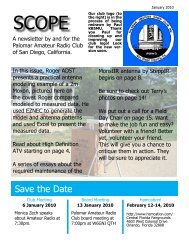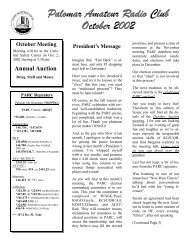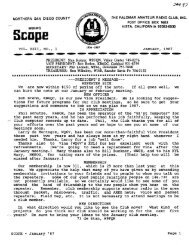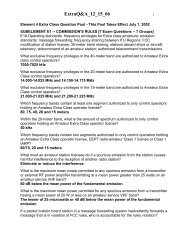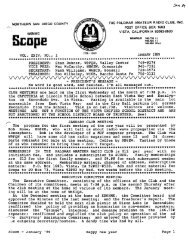Create successful ePaper yourself
Turn your PDF publications into a flip-book with our unique Google optimized e-Paper software.
Morse.s Invention and Its Predecessors<br />
in the United States" by Lewis Coe<br />
(1993).<br />
The great western surveys of the<br />
United States were resumed after the<br />
Civil War beginning with Powell's expeditions<br />
on the Colorado and Green<br />
Rivers. The surveys were consolidated<br />
in 1879 into the United States Geological<br />
Survey ofwhich Powel was director<br />
from fiscal year 1881 to 1894. Here is<br />
a bit of history from that era which<br />
hopefully you will find as interesting as<br />
I did. 73, Ed, KF6DXX<br />
The annual report ofthe secretary of<br />
war for the year 1895 contains the chief<br />
signal officer's report on the Glassford<br />
expedition that established the world's<br />
heliograph distance record. It reads as<br />
follows: (edited slightly)<br />
"On the morning of September 10<br />
(1894), as prearranged, we were ready<br />
and began with the sunrise to direct our<br />
glasses and flash in the compass direction<br />
ofMount Ellen (Utah), for not even<br />
the Henry Mountains group, of which<br />
Mount Ellen is one, was visible. No<br />
answering flash was seen until about 1<br />
o'clock in the afternoon, when we<br />
caught the first glimmer of the Mount<br />
Ellen flash, which appeared through the<br />
telescope of a deep reddish hue and to<br />
be about as bright as the planet Venus.<br />
It was visible for only a short time,<br />
however, though long enough to settle<br />
definitely the position ofthat peak.<br />
On the morning ofthe 11th the flash<br />
from Mount Ellen was again seen for a<br />
short time, and the Mount Uncompahgre<br />
(Colorado) flash was also recognized<br />
by the signalmen on the fonner.<br />
The 12th, 13th, and 14th were stonny,<br />
and the lower plateau intervening between<br />
the peaks seemed covered with a<br />
thick dust and haze which interposed a<br />
veil too thick to penetrate.<br />
On the morning ofthe 17th the horizon<br />
was clear, the Ellen flash distinct,<br />
and their messages read quite easily.<br />
The repeated message ofthe day before<br />
was sent by our party several times, and<br />
then our glasses were trained on the<br />
Mount Ellen station. I knew that ifthey<br />
sent back the same message they had<br />
read our signals. About 10 o'clock we<br />
received the closing part ofthe message<br />
and read it without difficulty. When<br />
finished it was begun again and the<br />
whole message was received this time.<br />
thus we knew that our flash had transmitted<br />
and the signalist's eye - 183 miles<br />
distant - had caught the words sent by<br />
the speaking sunbeam."<br />
(To appreciate this accomplishment recall<br />
that the participants did not have the<br />
use of telegraph or any other means of<br />
communication (no Ht's). If this piques<br />
your interest in signaling and heliographs<br />
it so happens there is a heliograph group<br />
in PARC - the Hikers Net Group. We<br />
haven't sent code yet or covered 183 miles<br />
between two states but we have signaled<br />
(2-way) up to 90 miles between Keller<br />
Peak near Big Bear and Cuyamaca Peak<br />
east ofSan Diego. 73, Ed)<br />
March Meeting<br />
The early Spanish explorers<br />
searched California and Arizona for the<br />
Seven Cities ofCibola. The cities were<br />
supposed to have streets paved with<br />
gold and unlimited riches. They<br />
searched for these cities through the<br />
16th, 17th and 18th centuries but they<br />
never found them.<br />
We members of the P ARC Hiking<br />
Group have found the cities ofCibola in<br />
rich valleys carpeted with golden flowers,<br />
and beautiful sparkling streams in<br />
the lofty mountains. We have hiked in<br />
the footsteps of the early explorers and<br />
have experienced the thrills of seeing<br />
what is around the next comer or over<br />
the next hill.<br />
Come and join us for the March<br />
meeting presented by our hiking group<br />
and you will be inspired to join us on<br />
some of our wonderful hikes.(73 's, de<br />
KE6ZLY)<br />
Old Times<br />
(old ames)<br />
Glenn Paden KE6ZLY@Juno.com<br />
I first moved to the homestead back<br />
in May of1932 about the 28th, I think it<br />
was. I was about 10 days old at the<br />
time. I do not remember too much about<br />
things back then. Life was pretty simple<br />
back in those days at the homestead.<br />
It was during the depres- pg.7<br />
sion and money was hard to come l~i~;<br />
by. My father homesteaded the Feb.<br />
property somewhere in the late<br />
twenties.<br />
It is a place called Oak Grove on the<br />
east side of <strong>Palomar</strong> Mountain. The<br />
homestead was located in the foothills<br />
right below the U.S. Forestry High<br />
Point look-out tower. The only public<br />
utilities the area had were a few crank<br />
phones and we were too far out for that.<br />
According to a sign along the road<br />
the population consisted of 7 nice people<br />
and 3 grouches and the man that put<br />
the sign up was one ofthe grouches.<br />
One of the first developments, after<br />
the house, was the spring in one ofthe<br />
canyons about a half mile above the<br />
house. The thing I remember most about<br />
the spring was my father blasting rocks<br />
out ofthe way to get to the water. As a<br />
boy it was so exciting to hear the charge<br />
go off and see all the rocks go sailing<br />
through the air.<br />
The first light in the house I remember<br />
was a Coleman lantern hanging<br />
from the ceiling which the tall people<br />
bumped their heads on. We would move<br />
the light from room to room as needed.<br />
Then in about 1935 we got real<br />
modem and wired the house for electric<br />
lights. For the source ofpower we used<br />
a 6 volt truck battery which we charged<br />
with a 6 volt gas powered DC electric<br />
generator. In 1937 we installed a Windmaster<br />
wind charger which gave us all<br />
the power we needed for lights and<br />
radio.<br />
We had a washing machine which<br />
used water lUlder pressure to operate the<br />
dasher. We also had a hydro-electric<br />
plant which consisted of a Bosh magneto<br />
with an automobile fan attached to<br />
it. A stream of water was directed at<br />
the fan to tum it and the magneto generated<br />
power for our electric fence to keep<br />
the animals in the right place. Once<br />
while walking near the house I ran into<br />
the electric fence with my nose. I saw<br />
stars in the middle ofthe day!<br />
For me, life on the homestead was a<br />
lot of fun. To my oldest brother it was<br />
hard work and living on pancake pota



